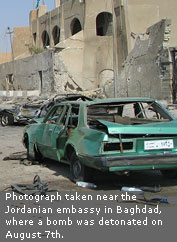PREVENTING
TERRORIST ATTACKS
Finding the "DNA" of Terrorist Bombs...and USING it
08/11/04
 On
the morning of July 28, a suicide bomber drove a car loaded with explosives
into a crowd of job applicants outside a police station in Baqubah, Iraq.
Sixty-eight people were killed and 60 more were injured. Also on July
28, a bomb exploded in a Kabul mosque, where Afghans were registering
for upcoming elections. On July 30, three coordinated bombs exploded
in Tashkent, Uzbekistan. On August 7, a bomb was detonated in Baghdad
near the Jordanian Embassy.
On
the morning of July 28, a suicide bomber drove a car loaded with explosives
into a crowd of job applicants outside a police station in Baqubah, Iraq.
Sixty-eight people were killed and 60 more were injured. Also on July
28, a bomb exploded in a Kabul mosque, where Afghans were registering
for upcoming elections. On July 30, three coordinated bombs exploded
in Tashkent, Uzbekistan. On August 7, a bomb was detonated in Baghdad
near the Jordanian Embassy.
It seems
like every time you pick up a newspaper, you read about a terrorist bomb
going off somewhere in the world. Why? Because for terrorists intent on
destruction, bombs are pretty easy and cheap to make...and so horribly
lethal.
But bombs
are also unique--custom made in a particular way, usually with an explosive
charge, a fuse, and a trigger. Which means they leave clues--possibly real
DNA, fingerprints, identifiable trace elements, but also a special "signature" of
design that can help us identify the bomb maker and his organization. How,
then, do we maximize those clues...and turn that information into intelligence
that might even prevent future incidents?
Global
terrorist bombings require a global response: thus TEDAC was born.
The TEDAC--or Terrorist Explosives Device Analytical Center--
is an FBI-led initiative, created in December 2003, that is committed
to establishing that global response by creating a single federal program
responsible for the worldwide collection, complete forensic and technical
analysis and timely dissemination of intelligence regarding terrorist
bombs. Every bit of information gleaned from TEDAC's analysis is shared
throughout the law enforcement, intelligence and military communities.
Drawing
linkages between terrorist devices and their makers--sometimes even continents
away--can add information to a case that could keep the next bomb from
going off. The intelligence is also used to develop new countermeasures
and to train first responders on improvised explosive devices actually
being used by the terrorists.
Who's
on the team? Top electronics specialists, explosives experts,
engineers, and counterterrorism agents and analysts from the FBI, the
Bureau of Alcohol, Tobacco, Firearms and Explosives and the Federal Air
Marshal Service, as well as assets from the U.S. Intelligence Community
and the Department of Defense.
What's
the volume of their work? To date, many hundreds of devices
been received--and similarities uncovered in many of them suggest many
terrorists are using the same bomb-making instructions.
And
in the days ahead? Expand, expand, expand--increasing the number
of agencies directly involved; the number of devices, post-blast debris,
and bomb-making materials it examines; and the amount of analysis TEDAC
conducts on each device. Its goal, however, will remain the same: To
Save Lives.
Link: FBI
War on Terrorism
